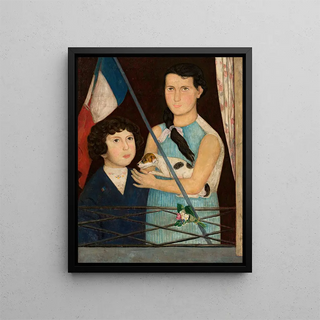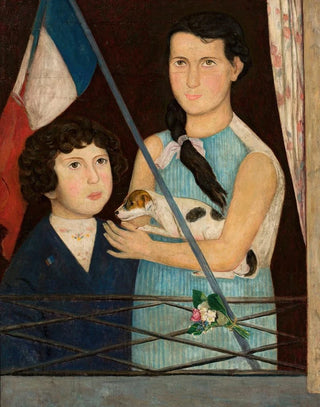Art print | Two children with a French flag - Tadeusz Makowski


View from behind

Frame (optional)
Captivating Introduction
In the fascinating universe of art, some works manage to capture the very essence of childhood, innocence, and nostalgia. The art print Deux enfants avec un drapeau français - Tadeusz Makowski belongs to this tradition, offering a poetic and touching vision of youth. This painting, imbued with delicacy and tenderness, transports us to a world where children, symbols of hope and the future, stand proudly under the tricolour flag. The piece evokes not only a national identity but also the dreams and aspirations of future generations. The scene depicted by Makowski resonates with an emotional depth that invites contemplation.
Style and uniqueness of the work
Tadeusz Makowski’s style is distinguished by his subtle use of colors and shapes. In this work, bright and warm hues create a joyful and lively atmosphere, while the soft outlines of the characters evoke a certain gentleness and childish naivety. The two children, with sparkling and lively eyes, seem to engage in a moment of play and complicity, while firmly holding the French flag. This juxtaposition between childhood innocence and the strong symbol of the national flag creates a fascinating tension, inviting the viewer to reflect on the link between personal and collective identity. The composition, though simple, is visually rich and demonstrates the undeniable talent of the artist in capturing fleeting moments and transforming them into timeless masterpieces.
The artist and his influence
Tadeusz Makowski, born in Poland, established himself as one of the most unique artists of his time. Influenced by the naive art movement, he developed a style that is his own, combining a childlike vision with themes deeply rooted in the social and political reality of his era. His work, marked by sensitivity to the human condition, resonates with the concerns of his time while transcending cultural boundaries. The depiction of children, often at the heart of his work, testifies to his attachment to lost innocence.

Matte finish

View from behind

Frame (optional)
Captivating Introduction
In the fascinating universe of art, some works manage to capture the very essence of childhood, innocence, and nostalgia. The art print Deux enfants avec un drapeau français - Tadeusz Makowski belongs to this tradition, offering a poetic and touching vision of youth. This painting, imbued with delicacy and tenderness, transports us to a world where children, symbols of hope and the future, stand proudly under the tricolour flag. The piece evokes not only a national identity but also the dreams and aspirations of future generations. The scene depicted by Makowski resonates with an emotional depth that invites contemplation.
Style and uniqueness of the work
Tadeusz Makowski’s style is distinguished by his subtle use of colors and shapes. In this work, bright and warm hues create a joyful and lively atmosphere, while the soft outlines of the characters evoke a certain gentleness and childish naivety. The two children, with sparkling and lively eyes, seem to engage in a moment of play and complicity, while firmly holding the French flag. This juxtaposition between childhood innocence and the strong symbol of the national flag creates a fascinating tension, inviting the viewer to reflect on the link between personal and collective identity. The composition, though simple, is visually rich and demonstrates the undeniable talent of the artist in capturing fleeting moments and transforming them into timeless masterpieces.
The artist and his influence
Tadeusz Makowski, born in Poland, established himself as one of the most unique artists of his time. Influenced by the naive art movement, he developed a style that is his own, combining a childlike vision with themes deeply rooted in the social and political reality of his era. His work, marked by sensitivity to the human condition, resonates with the concerns of his time while transcending cultural boundaries. The depiction of children, often at the heart of his work, testifies to his attachment to lost innocence.






